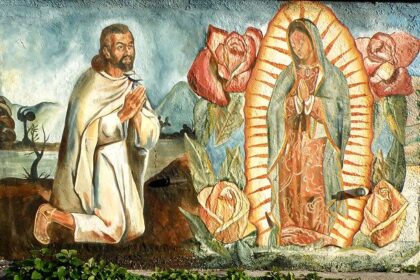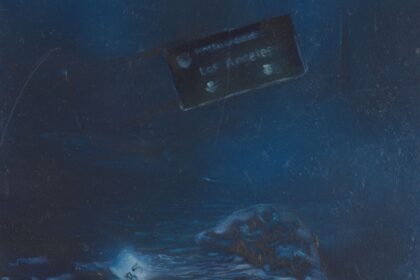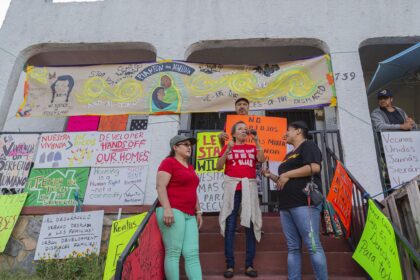An Interview with Evan Kleekamp
Erika Barbosa
September
356 Mission was an artist-run gallery and event space, created by artist Laura Owens, that had a contentious five-year run in Boyle Heights, Los Angeles between 2013 and 2018. Before opening the gallery Owens moved to the neighborhood in search of personal studio space. She rented a former piano warehouse on the 300 block of South Mission Road, a street that runs parallel to the channelized Los Angeles River. Zoned for heavy manufacturing,[1] this western pocket of the neighborhood was designed for industrial use dating back to the turn of the twentieth century, when the area was home to Mexican and Russian working-class communities which formed a historical enclave known as the Flats.[2] Over the last decade, warehouses along Boyle Heights’ riverfront edge have become popular real estate for metropolitan arts businesses. An influx of galleries east of the Los Angeles River has brought an international art market into a Latinx neighborhood with a median household income of $32,463 and an extremely low home-owner rate of twenty-four percent.[3] Anti-gentrification coalitions such as Boyle Heights Alliance Against Artwashing and Displacement (Bhaaad) have emerged to illuminate the role that artists and the art market play in rising property values and threats of displacement for local renters and economies. 356 Mission became a central figure in the gallery-boycott, in part because of a larger protest against the property owner that the artists leased from, whom the activists have argued is a sponsor of other development projects gentrifying the neighborhood.[4]
Noni Brynjolson and I first met with Evan Kleekamp in January 2018 to discuss Owens’ gallery, where Kleekamp had recently completed an internship and a subsequent freelance project. At the time of our initial conversation, 356 Mission was only months away from announcing its dissolution, a decision that Owens and co-founder Wendy Yao told the Los Angeles Times had “more to do with the natural life cycle of an artist-run space coming to an end than any protests.”[5] 356 Mission was not the first gallery to close: in 2017, another artist-run space (PSSST) attempted to launch a nonprofit out of a warehouse on East 3rd Street. In a statement on their closing, the founders of PSSST stated, “the ongoing controversy surrounding art and gentrification in Boyle Heights caused PSSST to become so contested that we are unable to ethically and financially proceed with our mission.”[6] Activists have stated that these galleries directly influence “the rising evictions, increasing policing and rapid displacement of working class communities” in Boyle Heights [7]. Their protests seem to be effective, with several galleries having either closed or relocated over the last few years. But to what extent can preventing the presence of art galleries influence the larger development plans already underway in the neighborhood? Long-term, city level projects are re-imagining much of Boyle Heights’ land use. The city’s new Boyle Heights Community Plan Draft, which re-writes zoning codes from 1946, [8] is designed to account for a projected population growth of eight percent over the next two decades. The Plan proposes to turn the industrial riverfront where galleries have settled into an “innovation district,” inviting green industries such as biotechnology to move to the area. Can the absence of art galleries slow down gentrification, given the larger city plans to make the area a “desirable place for innovative industries to locate”?[9]
Artist-run spaces like 356 Mission often serve as a resource for under-represented artist communities. Before 356 dissolved, Kleekamp noted:
the people that kept coming back to 356, even after the protests, are the people that needed it. The Ovahness Ball, for example, which is put on by queer and trans folks, often those who are living with or affected by HIV—they needed that space and were not afraid to ask for it. The artists who have typically criticized 356 have access to other spaces, or they don’t have as much economic pressure put on them. At a certain point, it became fashionable to criticize the gallery to hide one’s class status.
More than a year after 356 Mission closed, Evan and I met in Downtown Los Angeles. The conversation that follows takes a closer look at what defines an artist-run space: can it offer an alternative financial model for artists, providing more artistic autonomy than a conventional gallery? Who are the gatekeepers of arts funding? How do inequitable funding structures for the arts relate to, or inadvertently contribute to, gentrification? Where and how can artists in Los Angeles seek space and funding while remaining accountable to their impact on existing local economies?



Evan Kleekamp: I think everybody should be able to express their political autonomy. The protestors should be able to express their concern and dissent at the same time that somebody like Laura Owens should be able to establish an artist-run, counter-market space to generate critical dialogue. There’s traction and I think that traction is important in a market where power is asymmetrical, incongruent, and in constant flux.
Erika Barbosa: And you believe that this is a productive traction?
EK: Yes, it’s productive. Was it a messy conflict? Absolutely. Was it a necessary dialogue? I think so. I also think Laura has become the scapegoat in this larger conversation, which is why I brought this Chris Kraus’ book [Social Practices, 2018]. The book demonstrates some of the key things people get wrong about 356 within the first few pages. 356 was not a non-profit, for example. It was a for-profit gallery that was interested in financially supporting artists and artistic activity. And I believe one of the only places where Laura, Gavin, and Wendy could do that in Los Angeles was in Pico Aliso—near but not in Boyle Heights—not on the West Side. Because that kind of gallery can’t exist there, it’s not a cultural fit, and it would be a waste of funds that could otherwise go to mounting exhibitions. It was a logical, not hostile, decision.
“After being targeted by misguided anti-gentrification activists, 356 Mission Road, an event and exhibition space modeled on Kunstverein, run by the artist Laura Owens and the gallerist Gavin Brown, closed this Spring. Operating in the shadow of newly opened franchises of mega-galleries such as Hauser & Wirth, 356 Mission was the only professionally operated nonprofit contemporary art venue in L.A.” (Chris Kraus, Social Practices)
EB: Do you feel like there’s a kind of capitalist agenda behind some artists involving themselves in this debate?
EK: Absolutely. I think it’s safe to assume there is always a financial incentive—that’s what makes any activity sustainable. There’s also a number of artists who became key components of this activist movement in Boyle Heights. The Guardian even ran an article titled “Are white hipsters hijacking an anti-gentrification fight in Los Angeles?” around the time when I was still interning at 356. While conducting initial research around the gentrification controversy, I spoke to several white artists and critics who basically told me that, as white people, the discussion was better left to people of color—meaning they did not want to say how they really felt or risk negative attention. These people rarely considered their role in the economic problem the protestors had outlined. But they were happy to use the controversy to shield how little they had done to learn about or improve the situation. Now that the efforts to remove the galleries have somewhat subsided, which is curious to me, we can see the end results. 356 is gone but Maccarone is still there. Chimento, where I was hired as an assistant then immediately promoted to director to smooth the gallery’s transition to West Adams, still exists. I suspect gentrification will continue in West Adams but with less attention because it’s not proximal to the Arts District. MaRs Gallery is gone. But there’s a new space opening just over a mile away on Santa Fe, with, if I remember correctly, Susanne Vielmetter and Nicodim Gallery as its forerunners. All of the commercial activity that was going to be Arts District adjacent is still going to happen and now we won’t have any type of counter-market, artist-run space in that area—even Human Resources is set to close. That’s something I wish people discussed and had some context about: What does it mean for an artist to open an exhibition space? Why would an artist decide to circumvent the gallery system and choose Los Angeles as the place to do so? Because the thing that people in the art market have an issue with—and I’m talking about the collectors, dealers, art consultants, etc. who move between the primary and secondary market—they don’t want artists to have autonomy, there is no incentive for them to support that kind of activity. They don’t want artists to have political autonomy. They don’t want artists to own the means of production or distribution because that gets in the way of their investment plan—it gets in the way of sales, profit, and their investment portfolio!
EB: Although it’s true that the other artist-run space to briefly exist in Boyle Heights did so with a non-profit status, you had previously told me that Owens opened 356 as a for-profit space. What do you think drove Owens to want to run an exhibition space? And why do you think she chose to go the for-profit route?
EK: I do think that Laura Owens has artists and people that love art in mind. I can say from experience that Laura is more concerned with supporting artists than with turning the art into commodity. 356 was about mounting exhibitions that would be otherwise difficult to produce in Los Angeles, not about raking in cash. I think that’s what Chris Kraus was trying to say when she called 356 a “nonprofit,” but there’s a legal line that I want to be clear about: 356, like Orchard in New York, did not want to dissociate art from the private market, it wanted to show how the relationship between art and commerce, like any other field, is fraught with difficult questions. To me, that is an ethical choice: to show complicity rather than disavow it.
Was 356 a perfect space? Absolutely not. No such space exists. But I think if we don’t discuss this kind of autonomy, this political autonomy that comes with having an artist run space, then we’re in trouble. It means we have foreclosed the autonomy exercised by artists as freelancers, small business owners, and active members of their local economy. While I agree with the protestors that there is a link between gentrification and art galleries, I would also remind them that is the case because art is a powerful social tool: if you control art, you control critical dialogue, the intersection of commerce and politics. I also think we have developed a fetish for nonprofit art spaces because they sound anti-capitalist in name. A nonprofit is just a business organization that the federal government recognizes as conducive to its larger activity.
I’ve worked for several nonprofits. I made a joke with Robert Crouch, who runs what is now Fulcrum Arts and used to be on the Pasadena Arts Council, that I sometimes feel like I’m the only black person who works for arts organizations in Los Angeles. I have freelanced for several nonprofits where I have been the only black person in the room, or to have ever worked there. I have also been extremely and strategically underpaid by a number of arts organizations who needed a black face for whatever venture they were pursuing at the time. I am completely aware of these interactions and use them to conduct research: there is no better way to understand the situation than to place yourself inside it.
So, a lot of this stuff with Laura upsets me because, yes, it is true, she had the means to establish this space. Yes, it is true, that space became the center of a complex political problem. I also don’t think that her perspective is perfect or that she’s above critique—I’m not interested in those all-or-nothing positions. But I do think that choosing not to organize a nonprofit space was intentional and, to repeat myself, I think that’s actually an ethical decision. Because what you typically see is that the people who have the financial clout to assemble a nonprofit and become a member of its board are, by and large, white people who, for example, attach themselves to issues around poverty, race, or gender equality, and that becomes a way for them to advertise their philanthropic interests. This isn’t to say all nonprofits or philanthropists are wrong or evil. But surface-level philanthropy does nothing for the groups I just listed and it creates an economic condition in which people of color or people with disabilities, for example, become a product that is sold to other exceptionally wealthy people. Nonprofits that exploit the legal incentives to make money off exploited laborers are a particular concern of mine. Nonprofits, like many of these private collections that imitate museums popping up all over the world—the Marciano Foundation, to name one local example—can be advertisements that vogue as service-driven organizations. Laura and 356 at least acknowledged that there is no solution to this problem and sought to continue supporting artists in less than ideal conditions. To me, that’s just operating under and acknowledging capitalism—not a gentrification fetish.
EB: Yes, definitely. And I would argue that this is tied to the inequity and nepotism I see in public funding structures. County-level initiatives seem to want to address inequity in the arts. For example, I’d cite the “Cultural Equity and Inclusion Initiative,” which began as a report submitted to the LA County Board of Supervisors. Over the last three years the County has responded to this report by gradually rolling out new requirements for public funding.[10] I think it’s really positive that the Department of Arts and Culture is implementing annual assessments, free workshops and other informative resources to get nonprofits critically evaluating “cultural equity” and “inclusion” in their organizations, but I’m just skeptical as to how much these requirements will actually shake up the internal workings of so many of these arts nonprofits. I guess time and transparency will tell.
EK: If you do not organize as a nonprofit, you get to produce your own interpretation of diversity or equity. But you also become more vulnerable, more susceptible to critique, in the process: there is no municipal initiative you can point to in order to extricate yourself. And, as far as the local art culture goes, if you look closely, Los Angeles has a particular cultural capital in the international art market, and that carries a latent aesthetic agenda. I would argue that 356 actually was exhibiting a lot of work that was, if not counter to that agenda, at least agitated or disturbed it.
EB: In what sense?
EK: 356 was unique in that it did not tailor itself to the commercial market. The “complete” works that the commercial market demands were de-prioritized in favor of experimental work, especially from mid-career artists or artists that would otherwise be too conceptual to show in Los Angeles commercial gallery spaces. I am under the impression that the larger public has no real investment in their museums and, too, that private galleries strike the average person as pretentious and impenetrable. I didn’t even think that a career as an artist or artworker was possible until I visited the Art Institute of Chicago in 2015, which changed my life. I understand why people are resistant to galleries, but I think we need to recognize that the disappearance of mid-tier galleries correlates to the disappearance of political autonomy across the wider, international economy. Look at the collective global unrest we are seeing: it all relates to an increasing gap between the upper and lower classes. We’re losing the fat between them. I am not here to defend the American middle class. I am here to suggest that the widening gap between the impoverished and the ultra-wealthy also means that artists of color, women, people with disabilities, etc. will find less and less reception for their work, especially because that work is often political in nature. The content of our museums and galleries, like any other industry, reflects the material condition of our world. To hand that responsibility over to a few curators in a public museum seems like an easy way to evaporate what little political autonomy we have left considering that so-called public museums are funded by private interests who don’t even pretend to obscure or deny how such a position, on a board, for example, would benefit them economically. I guess you could say that my primary criticism of the protests is that they played right into the desires of the wealthy by creating a skirmish between the artists and residents who wanted political autonomy in an incongruent political economy. It should surprise no one that a female artist became the focal point of this conflict, the intersectionality people bandy about in their criticisms from time to time does play out in real life. An unfortunate majority of artists and critics I’ve spoken to about 356 feel comfortable labeling Laura—without even knowing her—as “satan,” a “cunt,” or “evil,” but have no idea about the ongoing redevelopment project that is the Arts Districts. That’s just misogyny, pure and simple.
EB: I think it’s also important to consider how artists with varying degrees of privilege and financial mobility have positioned themselves within this anti-gentrification discourse.
EK: But which artists are allowed to be ambitious? And I don’t mean that in the capitalist sense. Which artists are allowed to change the social structures? White male artists are not going to change the social structure. Why would a man want to change a system that works for him? People who occupy a comfortable position in society are not going to make art that demands change. It will always be artists of color, female artists, genderqueer artists, disabled artists, etc. who are trying to change the economic model. And I think what Laura did was try to change the economic model. And honestly, I think that when she tried to explain that no one listened. That’s why I’m sympathetic. There isn’t a clear-cut way to manage economic disparity in the arts, so until we have overcome this political milieu that continues to stratify along class lines, we need experimental spaces where heterogeneity is privileged. We also need to abandon the scapegoating strategies typically found in abusive families. Laura Owens did not cause or call for gentrification in Boyle Heights, and anyone who has been watching the situation knows that the artists are a pale threat in the face of the forthcoming development that will cater to the tech industries Los Angeles has been trying to attract. I wish people would invest more time and energy into understanding the city’s role in gentrification. I know that I will sound nostalgic when I encourage people to consider civic government, but property law is one of the few means we have to protect ourselves in cases where the economic disparity is so large. But to engage in a citywide discussion would require some aisle-crossing that I don’t think will happen if we focus on neighbor-specific conquests. The developers don’t think that way, and they have no reason to maintain the structures that they are actively trying to disintegrate.
EB: That’s a really important point that I think gets lost in the media noise of this “art as gentrification” debate.
EK: It took me a long time to get to that, I’ve done a lot of research and a lot of labor that was unpaid. This is another important thing to note: Laura Owens paid me a fair rate for the work I did. And my research at 356 inspired further research. It led me to take the position at Chimento knowing full well that it would implode. It led me to seek an unpaid but compensated position as a property manager. I perform simple management tasks in exchange for reduced rent. When I tell this to most people they bring up Issa Rae’s character from Insecure because she is also a property manager. To repeat what I said above: the people that need these spaces or positions are often marginalized and take the opportunity out of desperation or reluctance. For me, I wanted more experience working with contracts, landlords, tenants, and legal disagreements because it is relevant to my research practice. The housing crisis in Los Angeles is far more complicated—to a depressing degree—than people realize. We need to be thinking about the consequences of our legal infrastructure when it plays out 5, 10, 20 years from now. As it stands, most people believe that simply resisting change will alleviate their housing problems. But from my perspective some of the most vulnerable people risk entrenching themselves in a city whose cost of living will exceed their means in the next few years. It’s true that Los Angeles has some robust legal mechanisms that can protect tenants. But those mechanisms rely on tenants being fluent in property law and the language in their lease—people would actually need to engage with legal language for such mechanisms to take effect and redirect the market.
EB: So, did the business endeavors that Owens took on as an artist carry with them a kind of ethical desire to provide employment to the artist community?
EK: Yes, totally. As a person that works in the visual and literary arts, I feel comfortable saying that the attitude I get from most people in the literary world is that, “You’re black, you must talk about racial issues.” I always end up representing black voices and I always have to represent queer voices in that dialogue, too. I have no interest in being a representative, so for a long time, I resisted that dialogue, and I still do to some extent. A crystalized example: Contracts. Contracts are supposed to be dialogical in nature. If you don’t like your contract, change it. Most people that do business in the artworld try to avoid contracts because verbal agreements eliminate the paper trail. So, every single organization I worked at, if I had an ability to influence what’s in the contract, I did. And the resistance I was often met with, I think is a big indicator. All the projects I’ve done with Laura have been based on a written agreement or proposal. It should scare people that this is a rarity in Los Angeles.
Part of coming back to the city and doing all of this work is discovering how difficult it is to be proximal to these issues, and I feel lucky or spoiled to have them in range, but I also want to indicate how much I had to surmount in order to get here. That’s why I’m the only black person in all of these nonprofits—it takes a lot of work to land in Los Angeles and find an economically viable way of living here if you don’t have financial support or a larger community. And then you want to start an art practice on top of that? Throw in your studio costs, throw in your production costs . . . That’s something I credit Laura for, she created a space where emerging and mid-career artists had a point of intersection and could collaborate. The artists who were able to grow in that space will be the test of 356’s efficacy. But I think many of us will only be able to demonstrate our development in the years to come.
Evan Kleekamp lives in Los Angeles, where they founded NOR Research Studio. Their writing has appeared in X-TRA Quarterly Art Journal, Open Space (SFMOMA), the Los Angeles Review of Books, and, alongside Kim Calder, ASAP/Journal. Evan is a 2019 Andy Warhol Arts Writers Grant finalist.
End Notes
[1] See Boyle Heights’ Historical Society blog: Rudy Martinez, “The Russians of the Flats of Boyle Heights Go to the Movies, Part Two,” (Nov 22, 2017). http://boyleheightshistoryblog.blogspot.com/2017/11/the-russians-of-flats-of-boyle-heights_22.html
[2] Zoning is published online at the Boyle Heights Community Plan’s Interactive Map: http://www.bhplan.org/interactive-map.html
[3] Juan Lopez, “Boyle Heights Residents Face Significant Obstacles to Homeownership,” USC Neighborhood Data for Social Change (Accessed September 23, 2019). https://usc.data.socrata.com/stories/s/Boyle-Heights-Homeownership/ex88-te68/.
[4] For more information on BHAAAD’s protest against 356 Mission see “On 356 Mission Closing,” (April 2, 2018.) http://alianzacontraartwashing.org/en/bye_356mission_2018/
[5] Carolina Miranda, “Q&A: Artist-run space 356 Mission is leaving Boyle Heights. Founders Laura Owens and Wendy Yao explain why,” Los Angeles Times (March 30, 2018). https://www.latimes.com/entertainment/arts/miranda/la-et-cam-laura-owens-wendy-yao-356-mission-20180330-htmlstory.html
[6] Matt Stromberg, “Boyle Heights Art Space Closes, Blaming Anti-Gentrification Activists,” Hyperallergic (February 22, 2017). https://hyperallergic.com/360174/boyle-heights-art-space-closes-blaming-anti-gentrification-activists/
[7] Jennifer Velez, “Artwashing Fight Takes a Twist With Gallery’s Offer to Ceremonially Close in Boyle Heights,” LA Taco (April 24, 2018). https://www.lataco.com/artwashing-fight-takes-twist-with-gallerys-offer-to-ceremonially-close-in-boyle-heights/
[8] From the Boyle Heights Community Plan, http://www.bhplan.org/draftplan.html
“The Boyle Heights Community Plan Update is an effort to update the existing Plan (last updated in 1998) to:(1) reflect preferred future growth patterns in the area, (2) encourage wise growth, (3) identify appropriate locations for new development (4) address prevailing neighborhood and community issues, (5) protect residential neighborhoods from development that is out of character and scale.”
“The new proposed zones, developed in conjunction with DCP’s initiative to rewrite the City’s 1946 zoning code—known as re:code LA—facilitate improved development standards that address the form and shape of buildings; the design elements of buildings; and the ways in which buildings interact with the street to encourage new development that is compatible with the traditional architecture and pedestrian friendly environments that are commonly found in Boyle Heights.”
[9] In the Draft Boyle Heights Community Plan published in October of 2017, LU [LU?] Goal 12 states, “Boyle Heights, particularly the industrial district along the Los Angeles River, is a desirable place for innovative industries to locate.” (p 22) https://drive.google.com/file/d/0B5vZFy05DiQGbjhIbDBjX2dBOUU/view
[10] https://www.lacountyarts.org/funding/organizational-grant-program/ogp-grantseekers/ogp-grantseekers-apply [access date]











